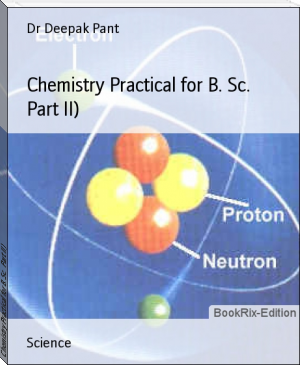Lab Manual Quantitative Analytical Method by Deepak Pant (best historical fiction books of all time txt) 📖

- Author: Deepak Pant
Book online «Lab Manual Quantitative Analytical Method by Deepak Pant (best historical fiction books of all time txt) 📖». Author Deepak Pant
Lab Manual
Quantitative Analytical Method
M Sc Pharmaceutical Chemistry I
1. Acid – base Reaction 2-25
2. Redox Titration 26-40
3. Precipitation Titration 41-48
4. Complexometric Titration 49- 59
5. Non- aqueous Titration 60-76
6. Chromatography 76-84
1. Acid-Base Titration
For Acid-Base Titration, the End Point is the condition at which the moles of acid exactly cancel out the moles of base. Hence the solution is neutral. We shall use the color changes of litmus and phenolphthalein to determine the End Point. Potassium hydrogen phthalate (KHP) or oxalic acid are primary standard used to determine the molarity of bases such as NaOH.
ACID-BASE TITRATION EXPERIMENT
Purpose: To determine the unknown concentration of a diprotic acid
Equipment: Titrant and Analyte Burettes, Buret stand, Erlenmeyer Flask
Reagents/Solutions:
NaOH (known concentration), H2SO4 (unknown concentration), Phenolphthalein
Procedure:
Prepare all glassware by standard laboratory procedure. Put 2 drops of phenolphthalein in the Erlenmeyer Flask. Utilizing the H2SO4 buret, deliver 3 mL into the flask by recording the initial volume of the buret, calculating the final volume required to deliver 3 mL of analyte and delivering that amount into the flask. It is extremely important to record the exact volume of acid delivered into the flask to the nearest 0.05 mL.
VFinal - VInitial = V Delivered
Fill the titrant burette (NaOH) with approximately 4.5 mL. Do a quick first trial run to estimate the approximate volume of NaOH required neutralizing the H2SO4 (turns clear to pink) then repeat with 3 runs, carefully recording volumes (initial and final) required to neutralize to the nearest 0.05 mL.
Name: ________________________________
Date:__________________
Analyte: H2SO4
S No Initial Volume Final Volume Volume Delivered of the ACID (mL)
1
2
3
4
Titrant: NaOH
S. No. Initial Volume Final Volume Volume Delivered of the BASE
(mL)
1
2
3
4
Known Molarity of NaOH:_________ Write a Balanced Equation for this reaction:
Experiment : Standardization of a solution of sodium hydroxide using a primary standard.
Needed:
1. 125-mL or 250-mL Conical flask be sure they are clean and dry.
2. Potassium hydrogen phthalate;
3. NaOH stock solution..
4. Burette for the NaOH
Clean, rinse well (with deionized water), and dry three 125-mL or 250-mL conical flasks. Measure between 0.20 – 0.25 g of potassium hydrogen phthalate into each. conical flask. Record Clean, rinse well (with deionized water), and dry three 125-mL or 250-mL Conical flasks. Measure between 0.20 – 0.25 g of potassium hydrogen phthalate into each Conical flask. Record the exact weight added to each flask to the nearest milligram. Add about 25-mL of water to each sample. Set the samples aside. Find out from your teaching assistant which unknown you will use. Obtain about 500 mL of the stock NaOH solution in a clean, dry beaker. Make a note of its unknown code. Prepare to titrate the KHP solutions by filling a burette with NaOH solution.
Rinse the burette with de-ionized water. Then, pre-rinse it with a portion of the NaOH solution before you fill it up for the titration. Pre-rinsing is necessary to insure that all of the solution in the burette is the desired solution, not a diluted or contaminated solution. To do this, add about 10 mL of the NaOH solution to the clean buret. Carefully turn the burette on its side so the liquid slowly runs out the top. Rotate the burette on its axis during this time to make sure the solution wets the sides all the way to the top. Pour the rinse from the burette into a waste beaker. Repeat the rinsing process with a second portion of the NaOH solution. By this time, the KHP samples should all be dissolved. If not, swirl their flasks gently. When you are sure they are fully dissolved, add 2 drops of phenolphthalein indicator to each. The solution should be colorless. Begin to titrate with the NaOH until you reach the endpoint.
The first titration should be performed by adding 0.50 mL portions of the NaOH solution, then swirling the solution. The approach of the endpoint is suggested by the temporary appearance of a pink color that fades when the solution is swirled for up to 10 seconds. A pink color that persists for more than 30 seconds signals the actual endpoint. (Note that the solution may lose its color after this; all you are looking for is persistence for 30-seconds or more.) This first titration gives you a rough idea of the amount of NaOH you need to neutralize the KHP.
Repeat the titration on the second and third samples of KHP. For these you can add about 70% of the needed NaOH quickly and then, near the end, add the NaOH one drop at a time until you see the endpoint.
Experiment: Determination of the molarity of a solution of hydrochloric acid using the NaOH secondary standard.
Needed:
1. Approximately 125-mL sample of HCl to titrate with your NaOH solution.
2. Four clean 125-mL or 250-mL Erlenmeyer flasks for the HCl ( In the absence of Erlenmeyer Flask Conical flask can use)
3. 25.00-mL pipet to transfer 25.00 mL of HCl solutions into each of the four flasks
4. Phenolphthalein indicator added to each HCl sample.
Clean and rinse well (with de-ionized water) three 125-mL or 250-mL flasks. Use a 25.00-mL pipet to transfer 25.00-mL of HCl solutions into each of the three flasks. Add 2 drops of phenolphthalein indicator to each.
Titrate the HCl solutions with the NaOH from the burette. Again, expect that you will overshoot the endpoint on the first run. Make an effort to be much more precise on the second and third trials.
Experiment : Determination of the molarity of a solution of sulfuric acid using the NaOH secondary standard.
Needed:
1. 125-mL sample of H2SO4 to titrate with your NaOH solution. Make a note of the unknown code of the H2SO4.
2. Four clean 125-mL or 250-mL Erlenmeyer flasks for the H2SO4
3. 25.00-mL pipet to transfer 25.00 mL of H2SO4solutions into each of the four flasks
4. Phenolphthalein indicator added to each H2SO4sample.
Use a clean dry beaker to obtain about 125-mL of your assigned solution from the stock bottle.Clean and rinse well (with de-ionized water) three 125-mL or 250-mL flasks.
Use a 25.00-mL pipet to transfer 25.00-mL of H2SO4 solutions into each of the three flasks.
Add 2 drops of phenolphthalein indicator to each. Titrate the H2SO4 solutions with the NaOH from the burette. Again, expect that you will overshoot the endpoint on the first run. Make an effort to be much more precise on the second and third trials.
Experiment: Analysis of Acetic Acid in Vinegar
Vinegar is a dilute aqueous acetic acid (HC2H3O2) solution. It reacts with sodium hydroxide as follows:
HC2H3O2 + NaOH ---> NaC2H3O2 + H2O
In this experiment you will analyze a vinegar solution to determine the percent acetic acid. As before, phenolphthalein will be used to signal when the acetic acid has reacted completely.
1. Tare an empty 50 mL flask. The flask needs to be dry on the outside but not on the inside. Add about 2 grams of vinegar to the flask and record the mass of the solution to the nearest 0.01 g.
2. Add one drop of phenolphthalein solution. Add NaOH from the buret while you swirl the flask. Occasionally rinse the insides of the flask with a little distilled water from a wash bottle. Continue adding NaOH until one drop causes the solution to change from colorless to very light pink. This time you cannot correct if you make the solution too pink. Record the final volume of NaOH to the nearest 0.01 mL.
3. Calculate the volume of NaOH used.
4. From the volume and the molarity of the NaOH calculate the moles of NaOH that reacted.
5. Use the mole ratio from the chemical equation to calculate the moles of HC2H3O2 that were in the vinegar solution.
6. Use the molar mass of HC2H3O2 to calculate the mass of HC2H3O2 in the vinegar solution.
7. Use the mass of HC2H3O2 and the mass of the vinegar solution to calculate the % HC2H3O2 in vinegar.
8. Refill the buret and repeat the experiment at least twice more.
9. Calculate the average % HC2H3O2 in vinegar.
Molarity of NaOH: _______________M Trial #1 Trial #2 Trial #3
Mass of vinegar
Final buret reading
Initial buret reading
Volume NaOH used
Moles NaOH used
Moles HC2H3O2 in vinegar sample
Mass HC2H3O2 in vinegar sample
% HC2H3O2 in vinegar
Average % HC2H3O2 in vinegar
Experiment : To determine the acid dissociation constants (Ka) of some weak acids.
Introduction
In water solutions, weak acids react with water to establish the equilibrium:
The equilibrium is represented by the acid dissociation constant, Ka, in which
Ka is a constant for a given acid at a given temperature. Its value can be determined by several experimental methods. Two of these that will be used in the experiment are:
1. measurement of the pH of a solution containing a known concentration of a weak acid and
2. measurement of the pH at the half-neutralization point in the titration of the weak acid with a strong base.
By following the pH during the titration of a weak acid with a strong base, you can obtain data that will enable you to calculate the Ka of the acid by both methods.
Titration Curves
In the titration of a weak acid, HA (having an ionization constant, Ka) with a strong base, a plot of pH against volume of base added will look like that in Fig. 1.
Figure 1: Titration curve for the titration of weak monoprotic acid with a strong base
That the graph should have this appearance is readily shown by the following reasoning. After each addition of base, equilibrium between the weak acid and its ion is reestablished, according to the relation:
Rearranging this Ka expression gives
Taking the logarithm of both sides of the expression and multiplying by -1, we get
or, in terms of pH and pKa (in which pKa = -log Ka),
This equation gives the pH at any [A-]/[HA] ratio. However, this ratio changes as base is added to the acid. The reason is that the reaction
is pushed further toward the right with each addition of base.
At the beginning of the titration, only the acid HA and the small concentrations of H3O+ and A- from its ionization are present. As base is added, the acid is neutralized, thus decreasing the concentration of HA. At the same time, salt formation increases [A-]. Throughout the titration, [HA] drops, and [A-] increases until all HA is neutralized. Eq. (1) tells us that as this happens and the ratio [A-]:[HA] increases from a low to a





Comments (0)